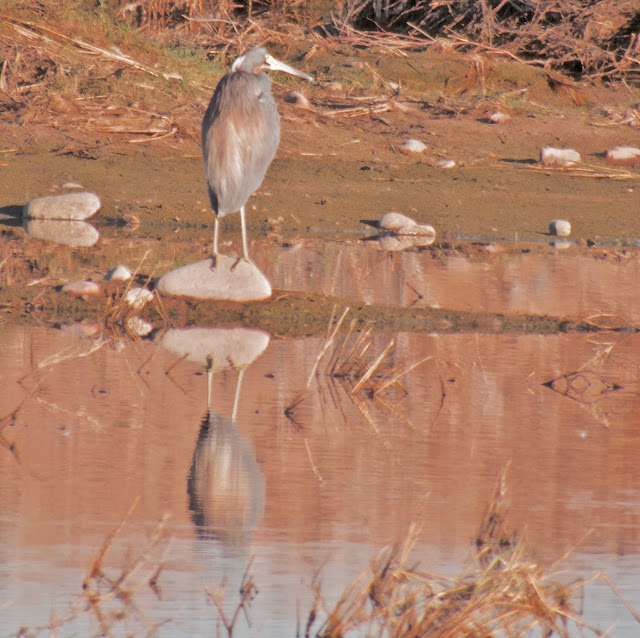Glendale Recharge Ponds, Glendale, AZ
August 4 & 10, 2017
With the desert heat cranking up a bit again, I needed some good birds to flavor my day. What better place to visit than a spot where two east-coast favorites somehow showed up in the past week — Glendale Recharge Ponds.
Marsha joined me for my first drive across Phoenix from the East Valley where we arrived at the ponds and began birding by 6 a.m. Although the early morning felt comfortable, temperatures have a way of riding up quickly in the desert.
The first eastern shorebird to arrive at the ponds was the TRI-COLORED HERON, the same species that had flown into the Gilbert Water Ranch ponds last year. Although it wasn’t in its last-reported location, another birder, Jeff Ritz, had watched it fly from Pond #1 where we started looking for it, so he quickly pedaled his bike back to let us know it was on Pond #3.
Not wanting to spook the TRI-COLORED HERON, we took photos from a distant corner. The long-slender-necked heron was perched on a smooth rounded light rock where it was busy preening. For me, clear photos were tough to come by so I’m posting Marsha’s that were somewhat better. (We don’t carry big cameras.)
The bird was an adult in mating plumage evidenced by its white head plume and the pale golden plumes on its rump. For me, the question becomes: How did it come to this pond? Was it blown off course? Did it just know it needed more food to complete its migration? Generally, the TRI-COLORED HERON is found along the Atlantic seaboard, but does wander northward and inland and will forage on inland lakes and freshwater marshes just about anywhere. So, we were lucky today! Will it stay?
 |
| Tri-colored Heron [Photo by Marsha Wiles] |
 |
| Adult Tri-colored Heron with white head plume and golden rump feathers [Photo by Marsha Wiles] |
After feasting at the Glendale Ponds for several days, the TRI-COLORED HERON would fly off to other unknown places but would occasionally return.
On my second visit to the ponds about a week later (8/10), it wasn’t there but had shown up the previous day when many birders descended to see the REDDISH EGRET that had also come in to Glendale’s Pond #4. Since its habitat is almost always in coastal areas (tidal flats, lagoons) and rarely inland or in fresh water, this seemed like a more important find.
Eagerly, I headed out pre-comuter traffic and arrived at the ponds while it was still mostly dark (5-ish). I set up my spotting scope and scanned Pond #4 with binoculars testing my ability to discern silhouettes. At least five GREEN HERONs were hugging the shore closest to me but not yet moving. GREAT BLUE HERONs were scattered throughout the pond (unless they were white egrets looking black in the still-darkness).
I thought (correctly, as it turned out) that the sought-after bird (REDDISH EGRET) was located, more or less, in the SE corner of Pond 4. I also thought the TRI-COLORED may have been in the NW corner, but Jeff Ritz who was sitting along the eastern edge of the pond (not visible until dawn arrived), told me it was a GREAT BLUE, one that had flown off.
Dawn seemed to signal the GREAT BLUEs and the GREEN HERONs to lift off to fly to their preferred breakfast buffets but the REDDISH EGRET stayed among the GREAT and SNOWY EGRETs in the SE corner.
As you can see in the photos below, the REDDISH EGRET is bigger than the SNOWYs, but smaller than the GREAT EGRET. Many birders were calling it a juvenile bird, but the distinctly bicolored bill (pink with black tip) is an ID marker for adults in breeding plumage. What was missing was its remaining shaggy neck feathers that I associate with having seen this bird on the Atlantic and Gulf Coasts. No expert, I don’t need to call its age but would guess it’s intermediate between first-year and adulthood. Below (and lead-in photo) are all of the REDDISH EGRET.
 |
| REDDISH EGRET |
 |
| REDDISH EGRET with SNOWY EGRETs |
 |
| REDDISH EGRET with SNOWY EGRETs |
 |
| REDDISH EGRET beside a GREAT EGRET |
The ponds were full of birds, including a CASPIAN TERN in our desert waters.
 |
| CASPIAN TERN background; BLACK-NECKED STILTs foreground |
 |
| NEO-TROPIC CORMORANTS |
 |
| WHITE-FACED IBIS |
 |
| Same WHITE-FACED IBIS lifting their heads out of the water |
Staying out there at the six open ponds with no shade is a challenge, but I lasted three hours while I scoped the smaller waders and sandpipers. While I got a good scope view of the PECTORAL SANDPIPER, it was too distant for photos. It appeared to be an adult bird (approx. 9"), with greenish legs and close streaking on the nape, throat and breast reaching down to the belly where the stripes stop precisely and cleanly.
As if my day had not already been full of a nice variety of birds, as I placed my gear into the trunk of my car, a male LAZULI BUNTING flew past with sunshine lighting up its special color of new blue feathers! What a day!
* * *
View this checklist online at http://ebird.org/ebird/view/checklist/S38476029
View this checklist online at http://ebird.org/ebird/view/checklist/S38576310


No comments:
Post a Comment